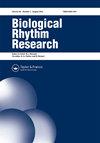青蛙脑中神经肽 "可卡因和苯丙胺调节转录物 "和 "神经肽Y "的昼夜变化
IF 0.9
4区 生物学
Q3 BIOLOGY
引用次数: 0
摘要
可卡因和苯丙胺调节转录物(CART)和神经肽Y(NPY)主要调节能量平衡。有尾目动物的行为具有昼夜节律性,但中枢神经肽的反应则具有昼夜节律性。本文章由计算机程序翻译,如有差异,请以英文原文为准。
Diurnal modulations of neuropeptides ‘cocaine- and amphetamine- regulated transcript’ and ‘Neuropeptide Y’ in the brain of E. cyanophlyctis
Cocaine- and amphetamine- regulated transcript (CART) and Neuropeptide Y (NPY) primarily regulate energy homeostasis. Anurans exhibit diurnal behavioral rhythm, but the response of central neuropep...
求助全文
通过发布文献求助,成功后即可免费获取论文全文。
去求助
来源期刊

Biological Rhythm Research
生物-生理学
CiteScore
3.00
自引率
9.10%
发文量
34
审稿时长
6-12 weeks
期刊介绍:
The principal aim of Biological Rhythm Research is to cover any aspect of research into the broad topic of biological rhythms. The area covered can range from studies at the genetic or molecular level to those of behavioural or clinical topics. It can also include ultradian, circadian, infradian or annual rhythms. In this way, the Editorial Board tries to stimulate interdisciplinary rhythm research. Such an aim reflects not only the similarity of the methods used in different fields of chronobiology, but also the fact that many influences that exert controlling or masking effects are common. Amongst the controlling factors, attention is paid to the effects of climate change on living organisms. So, papers dealing with biometeorological aspects can also be submitted.
The Journal publishes original scientific research papers, review papers, short notes on research in progress, book reviews and summaries of activities, symposia and congresses of national and international organizations dealing with rhythmic phenomena.
 求助内容:
求助内容: 应助结果提醒方式:
应助结果提醒方式:


